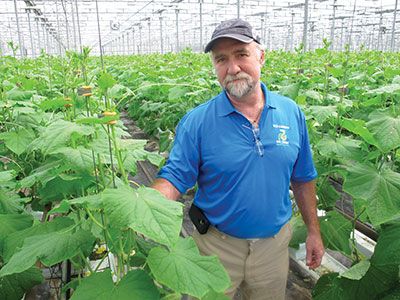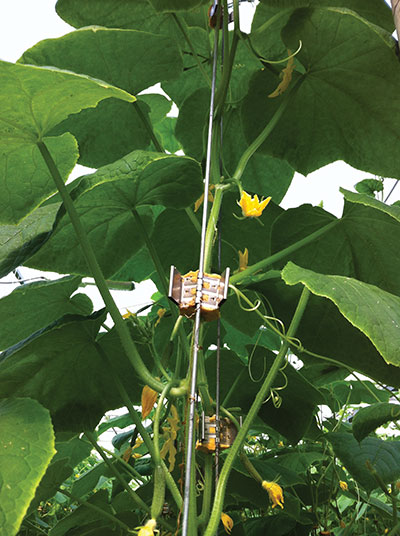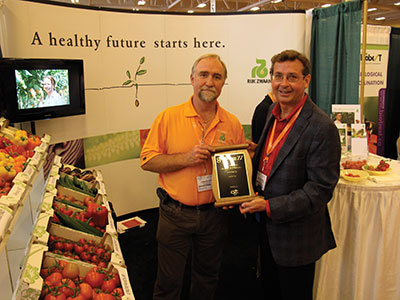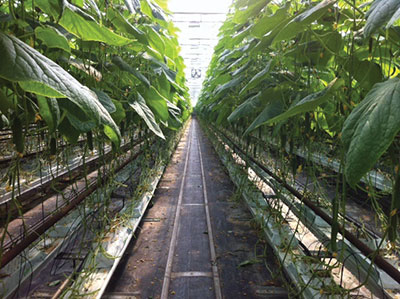
High wire cucumber production grown under lights can increase fruit
quality and yields, according to Leamington, Ontario, grower Howard Huy.
High wire cucumber production grown under lights can increase fruit quality and yields, according to Leamington, Ontario, grower Howard Huy.
 |
|
| Howard Huy in a new crop Advertisement
|
But it’s so different from the traditional umbrella growing method. Growers along with their employees must do their homework to optimize its benefits.
In fact, without a good system in place, it might mean reduced yields and quality, along with higher labour costs.
Huy has been working with the system for a number of years, and has a recipe for success he shared last fall with a presentation during the Canadian Greehouse Conference.
Under high wire production, “the plant is grown so the apical tip grows continuously without pruning,” Huy explains. “This changes the growing dynamic of the plant compared to conventional growing and therefore requires a different approach to the plant husbandry.”
Adding lighting means a longer growing period, resulting in more growth each day. “This extra growth presents the grower with challenges to stay on top of the crop in terms of picking and general crop work.”
MORE PRODUCTION, BETTER QUALITY
■ High wire may give more production and better quality, “but if the inputs are too high then the
profits may not warrant the transition,” says Huy.
 |
|
| Pellikan hook system works well for them.
|
He has been growing under lights since 2005, the first two years in small trials, before adopting a lighting program in his commercial crop in 2007. He’s probably been working with high wire crops under lights longer than anyone else in Canada. There are other growers in the Leamington region growing high wire cucumbers, but not with lights.
High wire cucumbers under lights can grow as much as one internode per day, suggesting much higher labour requirements.
But that doesn’t have to be the case. Huy says once growers develop a detailed schedule for crop maintenance and harvesting, labour requirements will be about the same as for traditional cucumber crops.
“The secret to growing a good crop on high wire is as much about managing the crop as the technical growing and environmental conditions.”
EXTENSIVE STAFF TRAINING
■ Additional employee training in the new program is essential. It may take some time, perhaps several months, for them to become fully proficient, but your patience will be rewarded.
 |
|
| RZH was a 2011 Best Booth winner at the Canadian Greenhouse Conference. Making the presentation was trade fair committee member Wayne Brown.
|
“So the only way to benefit from this is to have the same workers year over year. This is done on most farms but it is critical for high wire as the time needed to become really good at a task is lengthy.”
Once employees have the new skills and systems mastered, supervision is “minimized.”
Having employees specialize in certain skills is important, as is having them “care for” their own areas of the crop.
“It is always better to limit the amount of different tasks that a worker does, so they can become more proficient at a
specific task. This will significantly improve their performance in the crop. Lowering, pruning and deleafing should all be done by the same individuals.”
His crew has found great success using Pellikan hooks and clips. “This helps to increase speed in lowering,” he says, along with increasing the interval times.
Harvesting should be done by a different group of employees.
“Picking the crop is straightforward and has to be done every day, so to reduce labour costs, workers must be given the tools to more efficiently perform their tasks. This would include proper picking carts, sufficient bin sizes to accommodate the length of row to avoid having to go into the same row twice, and access to carts or bins so there is no waiting.”
Having employees work their own areas of the crop serves several purposes, says Huy. It ensures better quality control monitoring, makes piecework easier to record, and helps reduce the spread of disease.
Quality control is important with every crop, but it can be quantified more easily with high wire cucumbers than in other crops. “Since every task is the same on each plant, it is easy to observe at what stage of the schedule the plant is on. This easy observation makes it simple to assess the type of work being done.”
WEIGHING SYSTEM’S PROS AND CONS
■ High wire cucumber growing under lights has its advantages and disadvantages, Huy explains.
“Firstly, the quality of the fruit and production can both be increased under this method. This is the primary reason that this type of growing is now becoming more interesting to many growers.”
However, growers must take into account the extra input costs involved in establishing a good production program. There are no shortcuts.
“It will take discipline and patience on the part of the grower and supervisors to achieve a satisfactory result.”
The downside of high wire production, he notes, is that if growers don’t complete all aspects of the growing program and develop a good work crew, “the cost of growing in this manner can easily outweigh any financial benefit that might be had from the growing method. In fact it may result in decreased production and quality for the grower.”
FAMILY HAS DEEP FARMING ROOTS
■ Huy grew up in the business, helping out on his parents’ farm while growing up.
 |
|
| High wire cucumbers under lights can grow as much as one internode per day.
|
(In addition to being a grower, his father, John, began working with Rijk Zwaan NL many years ago, serving markets in eastern Canada. Howard has since taken over those duties, and is president of RZH Canada.)
After completing post-secondary studies, Howard worked off the farm for a year before returning home in 1981.
He began growing on his own in 1985 with two acres, and has since expanded the business to 24 acres, including a 3.5-acre expansion last year. The crop mix now includes long seedless and mini cucumbers, eggplant, tomatoes and peppers.
The family’s close ties with Rijk Zwaan make them a natural for trialling new varieties and products. “We’ve been working with them for 30 years. It’s a great company to work with, because it’s so innovative.
“We’re always trying something new here, because of the seed side of our business,” says Huy. “We’re always looking for something to introduce into the greenhouse industry here.”
Eggplant, for example, has enjoyed slow, but steady growth in the industry. And that’s all positive. “It’s been market driven.”
Combining a career as both a grower and a supplier is challenging and rewarding, says Huy.
“It’s so exciting to see what new products we can introduce into the market. There are endless possibilities. It’s like a blank canvas for an artist. The trick is to find something we can grow well and that is commercially viable.”
Print this page